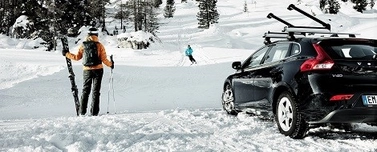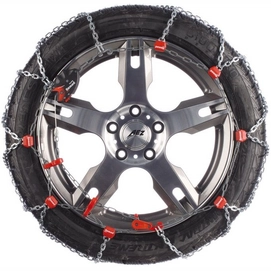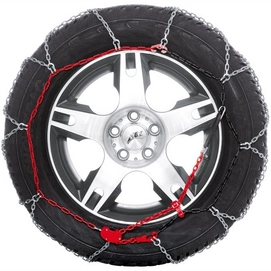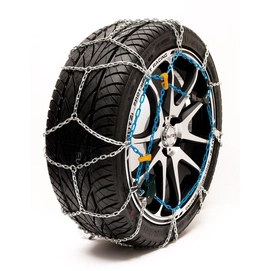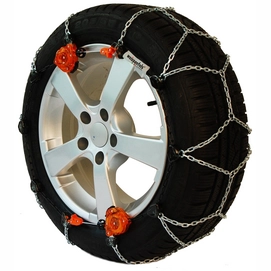Best Snow Chains
There are several factors that are important when choosing the right snow chains for your car. For example, you can look at price, quality, and functionality, but you also have to pay attention to the size of your tyres and the space in the wheel arch (inner clearance). For example, cheaper snow chains often do not fit in the wheel arches of a lot of more modern cars, which have less space in the wheel well. In addition, you also have to ask yourself if you want to go for a snow chain with manual or automatic tensioning system. If you follow the steps below, you can quickly choose the ideal snow chains for your car!
Step 1: Determining your tyre size
What is my tyre size?
Before choosing a snow chain, you will first have to determine your tyre size. Not every type of snow chain is suitable for the same tyre sizes. To ensure safe and proper operation of snow chains, it is very important that the snow chains fit exactly around your tyre. If this is not the case, the snow chains can damage your car. You determine your tyre size based on 3 sizes: the width of the tyre, the height to width ratio of the tyre, and the inch size or rim diameter. The images below show you exactly what you should look at.
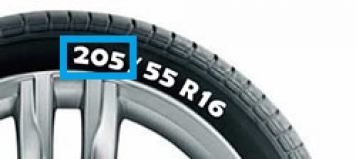
Tyre Width
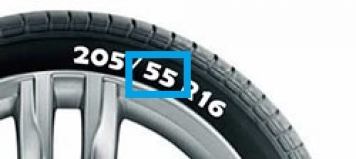
Height / Width Ratio
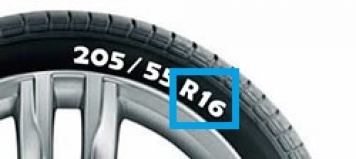
Inch size / Rim Diameter
After you have determined your tyre size, you can easily use our handy selection tool at the top of our homepage. This tool allows you to enter your tyre size so that all suitable and available snow chains are shown. The selection that is generated by this handy tool indicates which snow chains are suitable for your specific tyre size. However, you are not there yet! There are a number of other factors that influence the selection of the right snow chains and which will refine your selection. You can read more about that below.
Step 2: Choosing which mounting method
Snow chains with manual or self-tensioning?
After choosing the right tyre size, it is important to further refine your selection based on the tensionsing method. A distinction is made between the two main types of snow chains: snow chains with manual tensioning systems and snow chains with self-tensioning systems. Below you can read exactly what the differences are between these two types of chains.
Manually tensioned snow chains
Snow chains with manual tensioning systems are the more traditional type of snow chains. Manual snow chains have the advantage that they are relatively inexpensive, because you tension them yourself after mounting to chains your tyre. However, the disadvantage of this type of snow chain is that they require a little more practise before assembly. There are two steps required for mounting snow chains with manual tensioning systems. After about 20 metres, you will need to stop in order to re-tension the snow chains.
Self-tensioning snow chains
Snow chains with self-tensioning systems, or automatic tensioning systems, are a lot easier to assemble than those with manual systems. Self-tensioning snow chains require only one step for assembly and can often be assembled in under a minute. Moreover, self-tensioning snow chains automatically adjust the tension as soon as the car starts, so you do not have to stop after 20 metres to adjust it. The disadvantage of this, however, is that this type of chain is normally more expensive than snow chains with manual tensioning systems.
Step 3: Spacious or tight wheel arch?
Does my car have a large or small wheel arch?
As a final step, it is vital to determine whether your car has a spacious or tight wheel arch. Many modern (sports) cars are designed with tighter wheel arches. These tight wheel arches are better protected than older cars, because they have larger brakes, more advanced suspension, and wider tyres. Moreover, cars with powerful engines also need stronger snow chains or a tread chain.
However, standard snow chains are equipped with fairly thick links and are therefore not suitable for cars with a tight wheel arch. So: if you have a car with a very tight wheel arch, you need to choose an extra thin chain or a chain that has no chain on the inside of the wheel. That way, you are assured that your car will not be damaged and you can safely hit the road safely when it snows or is icy. A distinction is usually made between the types of snow chains for a tight wheel arch: a tread chain and an extra thin snow chain. Below you can read the differences between all three chain types, namely standard snow chains, extra thin snow chains, and tread snow chains.
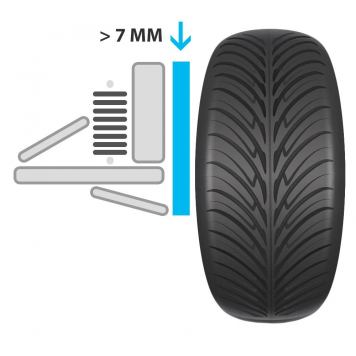
Standard snow chains
Chain thickness: 9 mm, 10 mm, 12 mm, or 16 mm
Suitable for: Cars with a spacious wheel arch
Assembly: Behind the wheel
As stated above, standard snow chains have fairly thick links and are therefore not suitable for cars with a tight wheel arch, because they can cause damage if there is not enough space to house the chain. Standard snow chains are usually attached to the rear of the wheel.
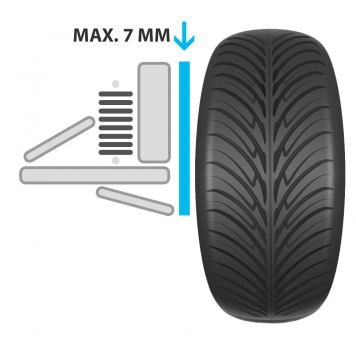
Extra thin snow chains
Chain thickness: max. 7 mm
Suitable for: Cars with a tight wheel arch
Assembly: Behind the wheel
Extra thin snow chains have a chain link thickness of up to 7 mm and are therefore suitable for use with cars that have a tighter wheel arch. Just like standard snow chains, this type of snow chain is attached to the rear of the wheel and is relatively simple to mount onto your tyres.
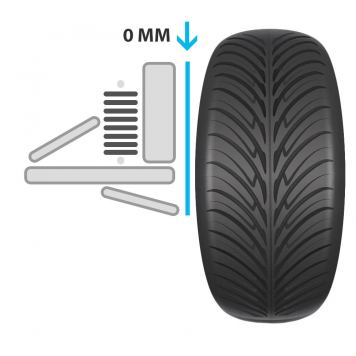
Tread snow chains
Chain thickness: 0 mm
Suitable for: Cars with a very tight wheel arch
Assembly: Front of the wheel
Tread snow chains, also referred to as external snow chains, are only attached to the tread of the tyre and around the outside, so there is no chain on the inner side of the tyre. Tread chains are specially made for cars with a very tight wheel arch and are mounted to the front of the wheel.
NOTE: Always carefully check your car's handbook or instruction manual or contact the manufacturer of your car to find out whether a snow chain larger than 7 mm is suitable for your car, or whether you need an extra thin snow chain or a tread chain. Checking this beforehand will prevent unwanted damage to your car.
Snow chains are always mounted on the driven wheels of your car. Do you have a car with four-wheel drive? Then it is advised to mount the chains onto the front wheels of your car, but we recommend that you always check first what your car manufacturer recommends.
Step 4: Also good to know
What else is important when choosing chains?
The various aforementioned factors should have the most important influence on your choice of the best model of snow chains for your car, however there are a number of other things that you can take into account when choosing snow chains, namely:
Aluminium and light alloy rims
Unfortunately, light alloy or aluminium rims can be damaged by more traditional snow chain models. It is therefore important to protect them properly to prevent any damage. The more expensive, high-quality snow chains in our range are often equipped with special rim clips to protect rims against snow chains. Wheel covers are even more susceptible to damage than rims, so it is advisable to remove them from your wheels before mounting your snow chains.
How many snow chains do I need?
Snow chains are sold in sets of two. The chains must be mounted on the driven axle. For most cars, this is on the front wheels, but with some brands or cars with a lot of power, the axle is on the rear wheels. When it comes to cars driven by all wheels (4x4 / AWD), it differs from car to car whether you need to mount the chains on your front or rear wheels. It is therefore important to follow the advice of your car manufacturer or information in your car manual.
Maximum speed with snow chains
It is also very wise to check the maximum speed at which you can drive with snow chains on your tyres before you set off on your journey. The maximum speed for metal snow chains is usually 30 mp/h (50 km/h), while textile snow chains often have a maximum speed of up to 25 mp/h (40 km/h). The maximum speed per snow chain is always indicated on the packaging or handbook, so check it carefully to ensure you are using your snow chains optimally.
Snow socks or textile snow chains
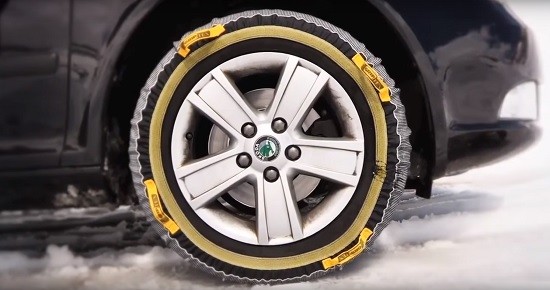
Why opt for a snow sock?
Snow socks (also called textile snow chains) offer a good alternative to standard snow chains, because they offer a number of advantages over regular snow chains. For example, snow socks are often easier and quicker to assemble, they do not interfere with the functioning of safety systems such as ABS and ESP, and they offer better protection for light alloy or aluminium rims. Snow socks are also a lot lighter than regular snow chains and therefore take up less space.
Although textile snow chains can be a lot more user-friendly, they also have some disadvantages compared to regular snow chains. For example, snow socks are a lot less durable, and will therefore need more frequent replacing, and offer less grip than standard snow chains.
Note: in several countries, snow socks are not actually permitted as a replacement for traditional snow chains, such as Germany or Austria. You should therefore pay attention to this when driving to a winter holiday destination. We advise that you only use snow socks in France or the Netherlands.
